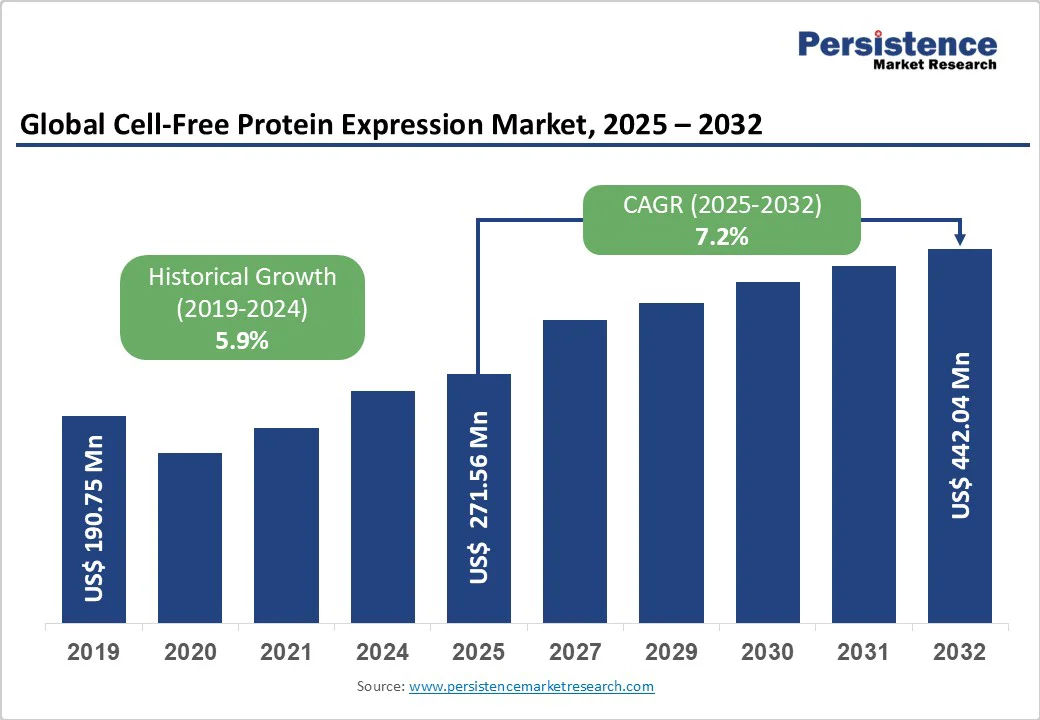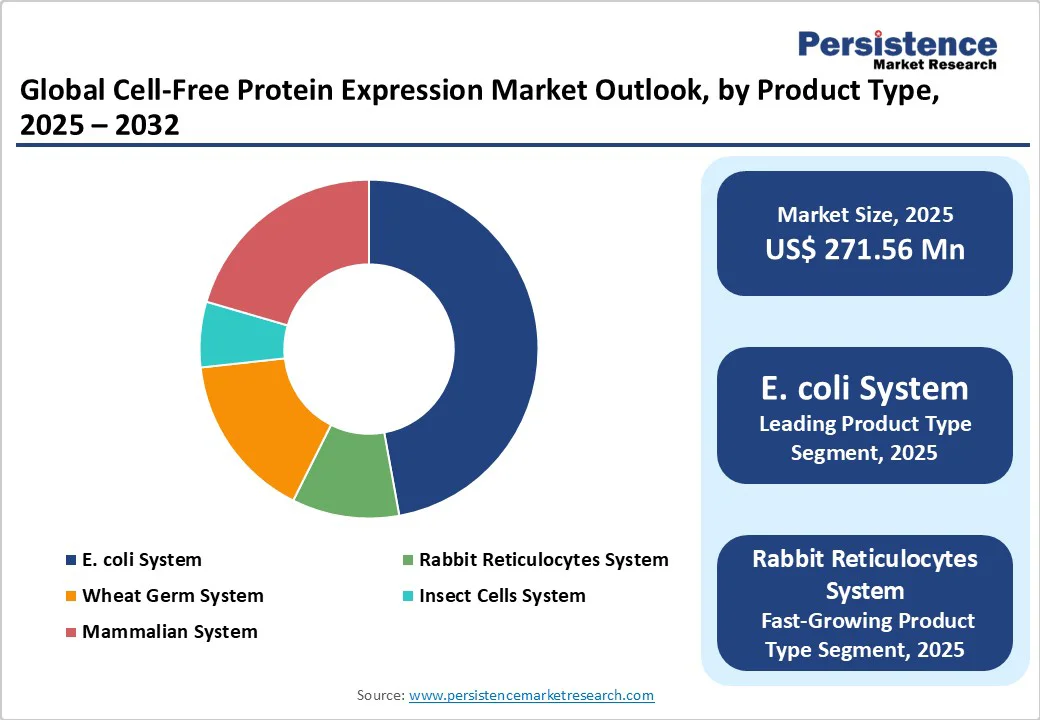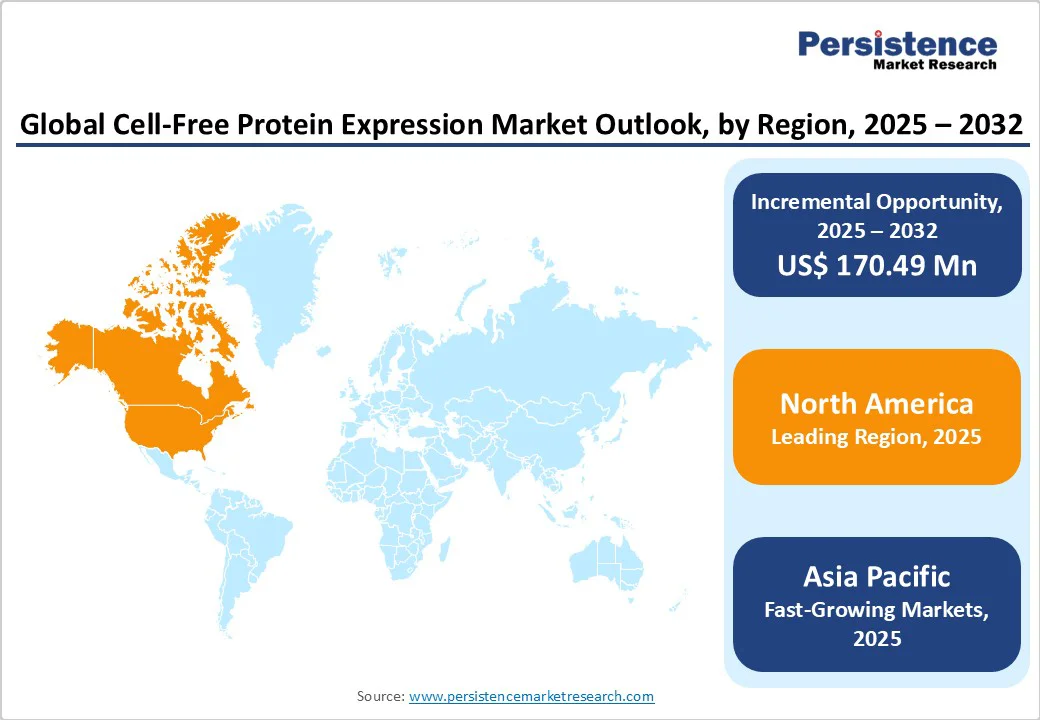ID: PMRREP12385| 189 Pages | 15 Oct 2025 | Format: PDF, Excel, PPT* | Healthcare

The global cell-free protein expression market size is likely to be valued at US$271.56 Mn in 2025 and is estimated to reach US$442.04 Mn by 2032, growing at a CAGR of 7.2% during the forecast period 2025−2032. Protein manufacturing is undergoing a revolution due to cell-free expression technologies, which offer sophisticated molecular targeting, reduced costs, and shorter production times.
| Key Insights | Details |
|---|---|
|
Cell-Free Protein Expression Market Size (2025E) |
US $ 271.56 Mn |
|
Projected Market Value (2032F) |
US$442.04 Mn |
|
Global Market Growth Rate (CAGR 2025 to 2032) |
7.2% |
|
Historical Market Growth Rate (CAGR 2019 to 2024) |
5.9% |

Researchers are increasingly exploring the use of cell-free protein expression systems (CFPS) to produce difficult protein classes, including membrane proteins and protein toxins, outside of living cells. A 2023 study aimed at enhancing the yield of a model membrane protein through cell-free expression (CFE) highlighted key challenges, such as aggregation of nascent chains and ribosome cotranslational membrane association. The study found that incorporating lipid membranes into the reaction enabled proper insertion of nascent chains and minimized aggregation, resulting in significantly improved protein yields.
Another study involving high-throughput cell-free screening of 61 eukaryotic membrane protein targets in lipidic mimetics, including detergents, liposomes, and nanodiscs, reported soluble expression of 57% of the membrane proteins in at least one format. Furthermore, a 2024 article, “Circumventing the Impossible: Cell-Free Synthesis of Protein Toxins,” demonstrated that the fast and efficient synthesis of protein toxins, typically difficult or impossible to express in living cells, is becoming feasible for medical and diagnostic applications with CFPS platforms. CFPS can be used to synthesize, functionally characterize, and even modify protein toxins for downstream applications. The CFPS is increasingly the preferred platform where cell-based systems fail, driving further investment and research into optimizing these systems for such hard targets.
Cell-free protein synthesis (CFPS) systems face notable intellectual property (IP) hurdles, as patents extend across extracts, energy systems, enzymes, and reaction methodologies. These protections restrict access to core technologies, particularly for academic researchers and smaller biotech companies. Common host or extract systems, such as E. coli–based CFPS extracts and wheat germ platforms, are often covered by overlapping patents, creating complex licensing requirements that drive up costs and limit commercialization opportunities for new CFPS applications. In addition to IP barriers, regulatory challenges further slow adoption.
Existing global regulatory frameworks for therapeutic proteins are primarily designed for cell-based biologics, leaving CFPS-specific standards undefined. This lack of clarity delays clinical trials and product approvals, raising perceived risks for pharmaceutical developers and discouraging investment in CFPS-based therapies. Recent initiatives in 2025, including collaborative IP-sharing models, open-source CFPS toolkits, and CEPI’s funding of LenioBio GmbH and Abera Bioscience, are beginning to ease these constraints. However, patent restrictions and regulatory uncertainties remain significant obstacles to large-scale industrial and clinical deployment of CFPS technologies.
Strategic collaborations with contract development and manufacturing organizations (CDMOs) and contract research laboratories (CRLs) present significant growth opportunities for cell-free protein synthesis (CFPS) providers, enabling them to scale their technologies and enter new markets. By leveraging CFPS innovations alongside the operational expertise of CDMO/CRL partners, companies can accelerate product development, enable rapid deployment of cell-free protein synthesis for research, clinical, and commercial applications, and support high-throughput workflows.
This approach addresses the growing global demand for vaccines, biologics, and advanced diagnostics, while offering flexible, cost-effective solutions across the biopharmaceutical and diagnostics sectors.
In April 2025, Ginkgo Bioworks partnered with ARPA-H, Tritica Biosciences, USP, On Demand Pharmaceuticals, and Isolere Bio under the WHEAT program to develop decentralized production of biologics and small-molecule APIs using wheat germ CFPS systems. Similarly, in October 2024, LenioBio GmbH collaborated with global CDMO ReciBioPharm to expand its CEPI-funded project, demonstrating the speed and capacity of its ALiCE® platform to accelerate vaccine protein production, supporting CEPI’s 100 Days Mission and highlighting the scalability and strategic potential of CFPS technologies.
In the global cell-free protein expression (CFPE) market, product type segmentation reveals distinct trends in adoption and growth. Among the various systems available, the E. coli–based CFPS system holds the dominant market position with 47.1% market share in 2024. Its widespread use is driven by factors such as ease of use, cost-effectiveness, high protein yield, and well-established protocols that have been refined over decades. Researchers and companies prefer E. coli systems for routine protein synthesis, high-throughput applications, and academic research, making it the backbone of the CFPE market.
On the other hand, the Rabbit Reticulocyte Lysate (RRL) system is emerging as the fastest growing segment. The growth is attributed to its ability to efficiently express eukaryotic proteins with proper folding and post-translational modifications, which are often challenging in prokaryotic systems. Increased demand for complex protein synthesis, including therapeutic proteins, membrane proteins, and functional protein studies, is driving the adoption of RRL systems. Technological advancements, improved kits, and rising research funding further accelerate its growth, positioning it as a high-potential segment within the CFPE market.
In the global cell-free protein expression (CFPE) market, the application segment shows varied growth dynamics. Among the different applications, the protein purification segment held a leading position in 2024, accounting for 39%. The increasing need for pure, functional proteins in research, diagnostics, and biopharmaceutical development drives this dominance. Protein purification workflows rely on CFPS platforms for producing proteins that are difficult to express in conventional cell-based systems, ensuring higher yields, faster production, and improved quality. Researchers and companies prefer CFPS-based protein purification due to its reproducibility, efficiency, and compatibility with high-throughput screening, making it a cornerstone application in laboratories and industrial settings.
The protein-protein interaction (PPI) segment is emerging as the fastest-growing application within the CFPE market. The growth is fueled by the rising importance of studying molecular interactions in drug discovery, functional genomics, and structural biology. CFPS systems enable rapid and scalable protein synthesis for PPI studies, allowing for the detailed characterization of complex interactions and accelerating the development of novel therapeutics.

The North American cell-free protein expression (CFPE) market is the largest regional segment, driven by strong research infrastructure, advanced biotechnology adoption, and significant funding for life sciences. The presence of key market players, top-tier academic institutions, and a robust biopharmaceutical industry supports widespread implementation of CFPS platforms in protein research, drug discovery, and diagnostic development. Government initiatives and grants, particularly from agencies like NIH, DARPA, and ARPA-H, promote innovation in synthetic biology and cell-free systems, further accelerating market growth.
Additionally, the rising demand for rapid, high-throughput protein synthesis for vaccines, biologics, and enzyme production is fueling adoption in both academic and industrial laboratories. North America also benefits from early adoption of cutting-edge technologies such as eukaryotic and membrane protein CFPS systems, enabling complex protein studies and therapeutic applications. Strategic collaborations with CDMOs and research institutions further strengthen the region’s leadership in CFPE adoption and innovation.
The Asia Pacific (APAC) CFPE market is the fastest-growing regional segment, driven by expanding biopharmaceutical research, increasing biotechnology investments, and rising adoption of advanced protein synthesis technologies. Countries such as China, Japan, India, and South Korea are investing heavily in synthetic biology, vaccine development, and biopharmaceutical manufacturing, creating high demand for rapid, scalable protein production platforms. The growth is also supported by increasing government funding, public-private partnerships, and establishment of research centers focused on cell-free systems. Rising collaborations with global CDMOs and technology providers help accelerate deployment of CFPS for therapeutic proteins, diagnostics, and vaccine development. Additionally, expanding academic research and growing contract research services are further boosting CFPS adoption in the region. The APAC market benefits from cost-competitive production, improving infrastructure, and increasing awareness of the advantages of CFPS over traditional cell-based methods, making it a high-potential and rapidly expanding market.

Leading manufacturers in the global cell-free protein synthesis market are actively working to enhance demand for their products and broaden their presence across various countries. These industry players are concentrating their efforts on obtaining FDA approval for their therapeutic solutions, which is a crucial step in ensuring safety and efficacy.
Market players are seeking to establish collaborative partnerships with local distribution networks, which will not only facilitate easier access to their products but also boost their market share and revenue. This strategic approach underscores their commitment to combatting the common fungal infection effectively while extending their influence within the global healthcare landscape.
The global market is projected to be valued at US$ 271.56 Mn in 2025.
Increasing Research Focus on Difficult-to-express Proteins Including Membrane Proteins and Protein Toxin Variants, strongly drive market growth.
The global market is poised to witness a CAGR of 7.2% between 2025 and 2032.
Cell-free Protein Synthesis (CFPS) is a groundbreaking technology that offers advantages, including protein expression, metabolic engineering, therapeutic development, and education.
Thermo Fisher Scientific, Promega Corporation, Takara Bio Company, New England Biolabs, Cube Biotech GmbH, and others.
| Report Attribute | Details |
|---|---|
|
Historical Data/Actuals |
2019 - 2024 |
|
Forecast Period |
2025 - 2032 |
|
Market Analysis |
Value: US$ Mn and Volume (if Available) |
|
Geographical Coverage |
|
|
Segmental Coverage |
|
|
Competitive Analysis |
|
|
Report Highlights |
|
By Product Type
By Expression Mode
By Application
By End-use
By Region
Delivery Timelines
For more information on this report and its delivery timelines please get in touch with our sales team.
About Author